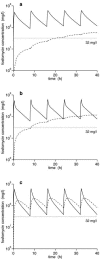Antibiotic abscess penetration: fosfomycin levels measured in pus and simulated concentration-time profiles
- PMID: 16251282
- PMCID: PMC1280140
- DOI: 10.1128/AAC.49.11.4448-4454.2005
Antibiotic abscess penetration: fosfomycin levels measured in pus and simulated concentration-time profiles
Abstract
The present study was performed to evaluate the ability of fosfomycin, a broad-spectrum antibiotic, to penetrate into abscess fluid. Twelve patients scheduled for surgical or computer tomography-guided abscess drainage received a single intravenous dose of 8 g of fosfomycin. The fosfomycin concentrations in plasma over time and in pus upon drainage were determined. A pharmacokinetic model was developed to estimate the concentration-time profile of fosfomycin in pus. Individual fosfomycin concentrations in abscess fluid at drainage varied substantially, ranging from below the limit of detection up to 168 mg/liter. The fosfomycin concentrations in pus of the study population correlated neither with plasma levels nor with the individual ratios of abscess surface area to volume. This finding was attributed to highly variable abscess permeability. The average concentration in pus was calculated to be 182 +/- 64 mg/liter at steady state, exceeding the MIC(50/90)s of several bacterial species which are commonly involved in abscess formation, such as streptococci, staphylococci, and Escherichia coli. Hereby, the exceptionally long mean half-life of fosfomycin of 32 +/- 39 h in abscess fluid may favor its antimicrobial effect because fosfomycin exerts time-dependent killing. After an initial loading dose of 10 to 12 g, fosfomycin should be administered at doses of 8 g three times per day to reach sufficient concentrations in abscess fluid and plasma. Applying this dosing regimen, fosfomycin levels in abscess fluid are expected to be effective after multiple doses in most patients.
Figures


Similar articles
-
Concentrations of fosfomycin in the cerebrospinal fluid of neurointensive care patients with ventriculostomy-associated ventriculitis.J Antimicrob Chemother. 2004 May;53(5):848-52. doi: 10.1093/jac/dkh158. Epub 2004 Mar 31. J Antimicrob Chemother. 2004. PMID: 15056646
-
High fosfomycin concentrations in bone and peripheral soft tissue in diabetic patients presenting with bacterial foot infection.J Antimicrob Chemother. 2009 Sep;64(3):574-8. doi: 10.1093/jac/dkp230. Epub 2009 Jul 3. J Antimicrob Chemother. 2009. PMID: 19578081
-
Target site penetration of fosfomycin in critically ill patients.J Antimicrob Chemother. 2003 May;51(5):1247-52. doi: 10.1093/jac/dkg187. Epub 2003 Mar 28. J Antimicrob Chemother. 2003. PMID: 12668580 Clinical Trial.
-
Principles of antibiotic penetration into abscess fluid.Pharmacology. 2006;78(1):1-10. doi: 10.1159/000094668. Epub 2006 Jul 19. Pharmacology. 2006. PMID: 16864973 Review.
-
Clinical significance of the pharmacokinetic and pharmacodynamic characteristics of fosfomycin for the treatment of patients with systemic infections.Int J Antimicrob Agents. 2009 Dec;34(6):506-15. doi: 10.1016/j.ijantimicag.2009.08.013. Epub 2009 Oct 13. Int J Antimicrob Agents. 2009. PMID: 19828298 Review.
Cited by
-
In vitro antibacterial effect of fosfomycin combination therapy against colistin-resistant Klebsiella pneumoniae.Infect Drug Resist. 2018 Apr 24;11:577-585. doi: 10.2147/IDR.S160474. eCollection 2018. Infect Drug Resist. 2018. PMID: 29731646 Free PMC article.
-
The Potential Role of Fosfomycin in Neonatal Sepsis Caused by Multidrug-Resistant Bacteria.Drugs. 2017 Jun;77(9):941-950. doi: 10.1007/s40265-017-0745-x. Drugs. 2017. PMID: 28456943 Review.
-
Penetration of fosfomycin into IPEC-J2 cells in the presence or absence of deoxynivalenol.PLoS One. 2013 Sep 6;8(9):e75068. doi: 10.1371/journal.pone.0075068. eCollection 2013. PLoS One. 2013. PMID: 24040387 Free PMC article.
-
Pharmacodynamics of Linezolid Plus Fosfomycin Against Vancomycin-Resistant Enterococcus faecium in a Hollow Fiber Infection Model.Front Microbiol. 2021 Dec 14;12:779885. doi: 10.3389/fmicb.2021.779885. eCollection 2021. Front Microbiol. 2021. PMID: 34970238 Free PMC article.
-
Fosfomycin as a potential therapy for the treatment of systemic infections: a population pharmacokinetic model to simulate multiple dosing regimens.Pharmacol Res Perspect. 2018 Feb;6(1):e00378. doi: 10.1002/prp2.378. Pharmacol Res Perspect. 2018. PMID: 29417760 Free PMC article.
References
-
- Akimoto, Y., Y. Mochizuki, A. Uda, H. Omata, J. Shibutani, H. Nishimura, M. Komiya, K. Kaneko, and A. Fujii. 1994. Amoxicillin concentration in pus from abscess caused by odontogenic infection. Gen. Pharmacol. 25:111-113. - PubMed
-
- Akimoto, Y., H. Nishimura, H. Omata, J. Shibutani, K. Kaneko, T. Kawana, T. Kaneda, H. Yamamoto, and A. Fujii. 1996. Cefaclor concentration in pus from abscess caused by odontogenic infection after a single oral administration. Gen. Pharmacol. 27:177-179. - PubMed
-
- Bartlett, J. G. 1984. Experimental aspects of intraabdominal abscess. Am. J. Med. 76:91-98. - PubMed
-
- Barza, M., J. Brusch, W. G. Bergeron, and L. Weinstein. 1974. Penetration of antibiotics into fibrin loci in vivo. 3. Intermittent vs. continuous infusion and the effect of probenecid. J. Infect. Dis. 129:73-78. - PubMed
-
- Barza, M., and G. Cuchural. 1985. General principles of antibiotic tissue penetration. J. Antimicrob. Chemother. 15:59-75. - PubMed
MeSH terms
Substances
LinkOut - more resources
Full Text Sources
Other Literature Sources
Medical

